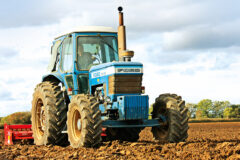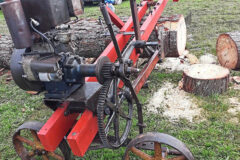Dinky-sized Austin Seven vans
Posted by Chris Graham on 5th February 2024
Brian Culpan profiles a pair of dinky-sized Austin Seven vans of the sort that were so popular with small businesses in the 1920s and ’30s.
Photography: Andrew Hardy and Herman Arentsen

This 1929 C cab Seven van oozes nostalgia.
The red C-cab van UX 4810 represents an early Type AD. It has some very interesting vintage features, such as levers at the steering wheel centre to control the ignition and fuel mixture. However, this very smart little van has a secret past, it was not a van when new! It left the factory in 1929 as a Type RK fabric-bodied saloon, ch. No. 76782 car no. A7-9274, eng. No. 80280. In the late 1990s, it was bought by Barry Goodman, its fabric bodywork and frame were totally rotten and beyond saving – so were scrapped. A brand new, replica van body from John Heath Coachbuilders Ltd, was purchased and fitted (this often came as a kit of parts with very detailed, handwritten assembly instructions). The finished van looks totally authentic. So, this vehicle could have left the factory as a van but didn’t. However, it is a van now, looks correct and would be indistinguishable from a factory van; except it does not have the Thomas Startin body plate but a Heath one. Because the bodywork is relatively new it is in excellent condition, and the bright red paintwork is a real ‘head-turner’.
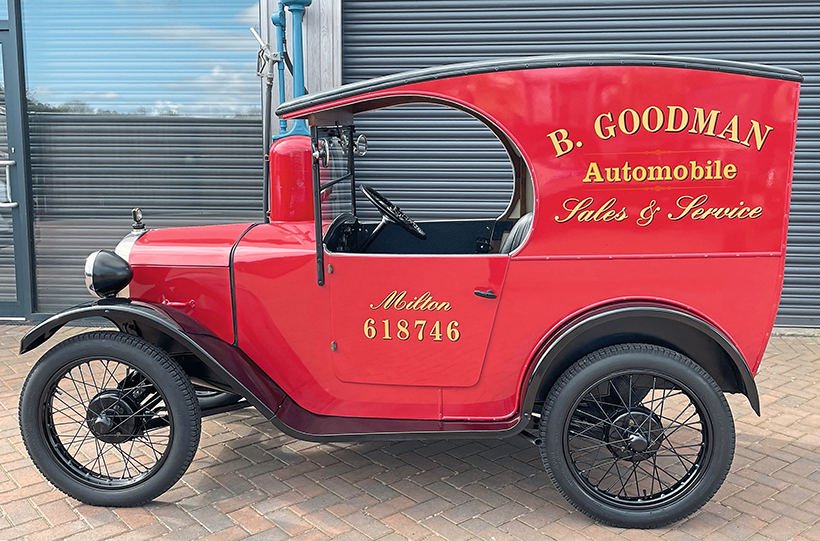
1929, vintage era van fills up from a vintage pump.
The chassis (from the original saloon) was first registered on 21st May 1929. Because the early vans were based on the tourer they could only cope with a payload of 2.5cwt. The 747cc sv engine is the usual Seven one rated at 7.8hp with a non-synchromesh, three-speed gearbox, short open propellor shaft, torque tube, then spiral bevel final drive unit. Wheelbase is only 6ft-3in.

A perfect restoration.
Early model history
Early vans, Types AB, AC, and AD 1923-30 and the AE 1929-30, were all based on the ‘Chummy’ tourer and bodied by Austin’s preferred bodybuilder Thomas Startin of 71 Aston Road North, Birmingham. Because the early vans were built on car chassis; they didn’t have their own identity on the ‘VIN plate.’
October 1923-1926 Types AB and AC – tourer-based vans had their front lamps on the scuttle, a half-width full-height partition behind the driver had a rectangular window, roll-up clear side screens for the cab doors, later a bench seat, no door handles, oval windows in the twin rear doors. All bodies by Startin were constructed from aluminium panels on an ash frame.
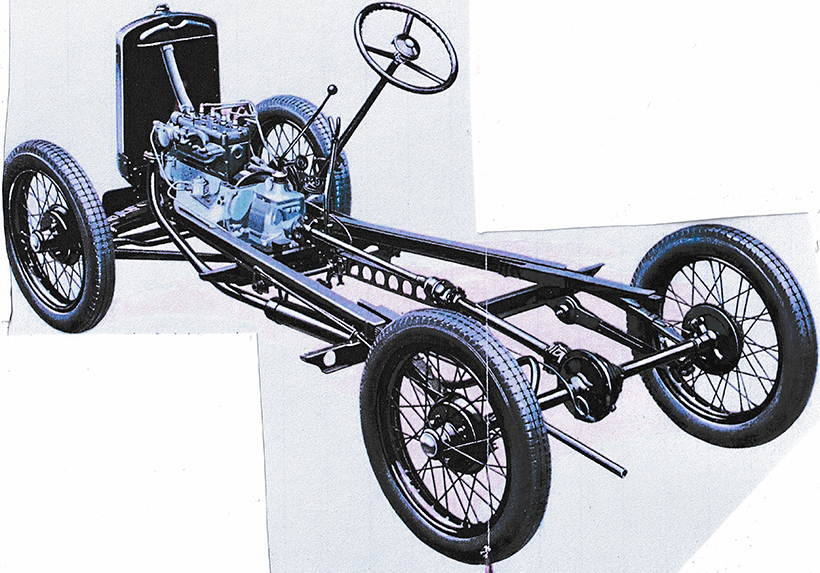
Austin Seven chassis.
AD Type 1926/7 also tourer based, but had an oval window in the partition, external door handles, four-piece bonnet (from Oct 1926), and driver’s door now had a sloping rear edge, headlamps on the front wings. Behind the driver was a full-height, half-width partition.
AE Type 1927-29
All, initially, still had black radiator and scuttle lamps, then nickel finish radiator, wing lamps and coil ignition. 1388 built – bodies mostly by Startin (C-cab) with a few by Gordon England – better cab; the driver now had a square, full-width, rectangular two-sliding glass window. 1927-29. Payload still only 2.5cwt.

By 1939, new pressed steel techniques were providing smoother bodies.
Type VD was the first Austin-bodied van swb1929-31 based on the AE tourer and RK saloon but with stronger springs, wider doors, scuttle ventilators. From 1931, volume increased to 46cu.ft, short bonnet, about 100 built.
The 1931 VE model was similar but based on the RL saloon, it had rectangular windows in plain rear doors, spare wheel was carried vertically – behind the passenger seat, vacuum powered windscreen wiper, scuttle ventilators, about 1,100 were built by Austin.

C-cab Seven has well-contoured seats, and a massive steering wheel.
Thomas Startin coachbuilder
While the tourer bodies were built and fitted at the factory, chassis destined to be vans were bodied by Thomas Startin Ltd. Complete running chassis were driven to the body builders – also in Birmingham. This company had been formed in 1840 as carriage builders, in October 1923, it became an Austin dealer and at the same time won the contract to body nearly all Seven vans (a few were later completed by Gordon England) before Austin took the work back in-house in 1930.
The last type of Seven vans were based on the Ruby saloon and were: Types AVJ and AVK. Their Type letters appear as a prefix to the chassis number.
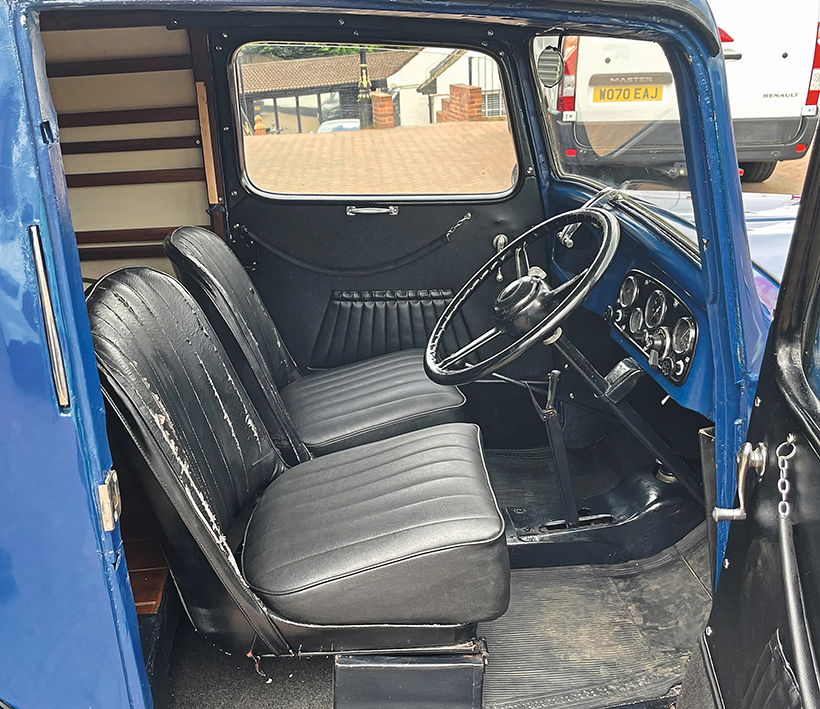
Driver’s door closing pull is interesting use of chain.
Blue Austin Ruby van FKT 530
Built just a decade later, this 1939 van was based on the New Ruby car, and uses a lot of pressed steel panels in its bodywork. New to Frederick Charles Brown, the registered keeper on behalf of Brown Bros., who were dairymen at West Court Farm, Detling, Maidstone. It was finished in the factory shade of dark blue and liveried ‘Brown Bros,’ In that era it was normal for a vehicle to be registered in the name of an individual, this was often the Secretary of a company (chief administrator) on behalf of the company or partnership. Registered with Kent County Council as FKT 530 on 13th April 1939, believed to be the very last Ruby van to leave the production line in Longbridge, and is a Type AVK ch.no.290958 eng.no. 292920. It continued to be used on the milk round (taxed every quarter for £2-15s) until the end of 1960. By then it had probably come to the end of its useful life, MoT tests had been introduced that year; initially on a voluntary basis but would become compulsory early in the following year. So, in anticipation of failure, it was taken off the road and put aside. Many owners of old vehicle were worried despite the test only checking three basic safety aspects of: brakes, lights, steering – symbolised by three safety triangles forming the early MoT testing centre sign.

View of the cab from the driver’s seat.
A decade later, 26th October 1970, it was bought for preservation by John Philip Hobb-Chambers of Chatham also in Kent. Then, at some time in the 1970s it passed to another enthusiast, Ronald Garside of Sidcup (staying in the same county). He kept it, unrestored until it appeared at the 2016 Beaulieu Autojumble in its original dark blue factory paint and though faint, the lettering could just be made-out, ‘Brown Bros.’ In very poor state, lots of surface rust, no front wings, the roof canvas had disintegrated.

New Ruby-based Seven van.
It was seen and bought by Barry Goodman, he discovered that the underside was rotten. It was kept unrestored for a while then joined by a similar but slightly older Ruby from 1938 (and just 50 chassis nos. difference) from Nigel Ricardo to be a donor – they stood side-by-side for several years while awaiting attention.
When the work got underway, the donor van gave its good floorpan to the younger van. Eventually the full restoration work was finished and the van emerged in top condition. The mileage displayed was 63,504. Following Barry’s passing it was sold as lot 27 at South Western Vehicle Auctions on 24th April 2023. Bought by Andrew Hardy of Coxhoe, Durham, classic vehicle dealer. Then soon sold to Herman Arentsen in the Netherlands where it is treasured.
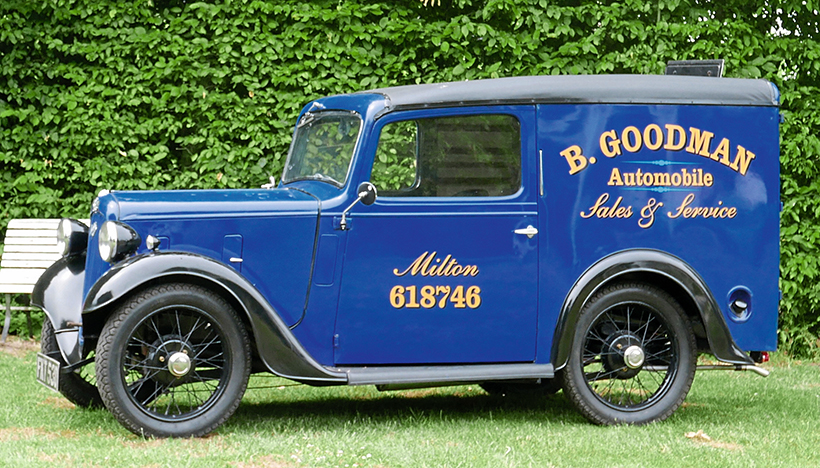
For a small van, it was quite long.
Last vans’ specifications
September 1935-July 1937, Type AVJ Ruby based, lwb, semi-Girling hydraulic brakes, three bearing crankshaft came in August 1936; gaining a centre bearing allowed designers to increase the CR (compression ratio) 6.1:1 allowing faster revving. At the same time a sprung clutch centre plate was fitted for smoother take-offs, steering became worm and sector. Cast iron drums, steel shoes, flatter roofline. Synchromesh on all but 1st gear, electric windscreen wiper.
AVK New Ruby based, July 1937 – 1939, lwb low frame, deeper wing valances, and painted headlamp shells chrome rims, flush-fitting trafficators, fabric roof, rear floor raised to give flat load area, all-steel body (not aluminium) on wooden frame. October 1938, full Girling hydraulic brakes. The 1938/9 Austin Seven factory vans were available in red, green, blue, black, or primrose, cost was an extra £3-10s, other colours would be £5 extra.
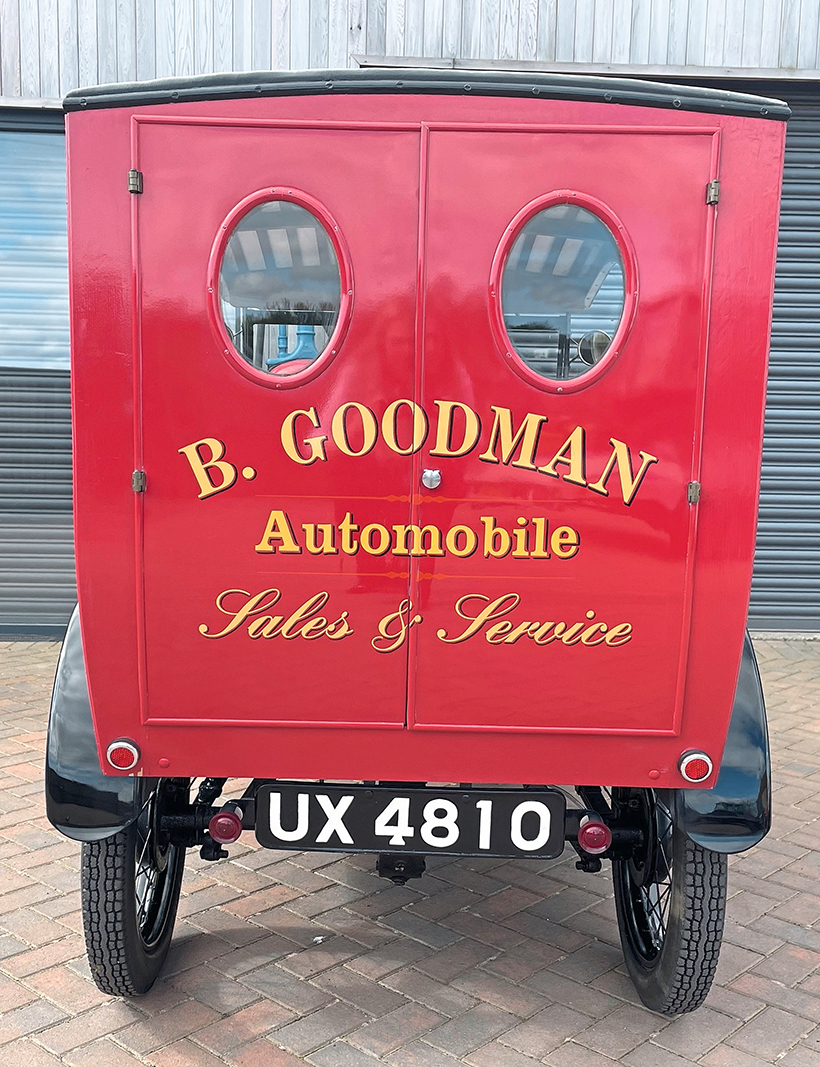
Large, oval rear windows aid safe reversing.
The Seven’s conception
Herbert Austin was a very clever and far-seeing man; he was convinced that a market existed for a baby car; a scaled down large car not one made from motorcycle parts (cycle car). Austin mentioned his ideas to close friends and senior colleagues – they laughed. Trying to gain support, he also shared his idea with his board of directors and creditors – they all laughed at him. Undeterred, Sir Herbert went ahead, borrowed his chief cashier’s Rover Eight and closely examined it, running the ruler over every possible dimension taking detailed notes before embarking on his now legendary design for a better vehicle. Austin’s target was to beat the popular motorcycle and sidecar outfit (the Seven would even use the same size and type of wheels and tyres). By being no larger but providing better, ideal, transport four a family of four, two adults in the front bucket-type seats, with the children sharing a small rear bench seat. Obviously, it is easier to look at an existing design and improve on it – going first, starting with a blank sheet of paper is far more difficult.
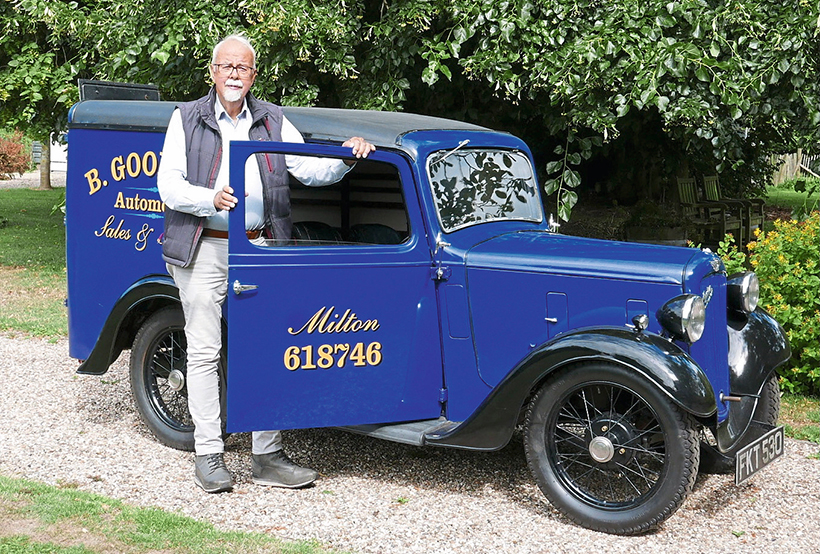
New owner in the Netherlands, Herman Arentsen.
Another light car that Herbert Austin looked at very closely was the recently introduced French Peugeot Quadrilette Type 161 of 1921. It had several eccentric features – the passenger and driver sat in tandem; each had a door but on opposite sides. Only rear brakes were fitted; the handbrake worked the right-hand one, the footbrake the left! Because it was so narrow no differential was thought necessary. However, it did have its three-speed crash gearbox in-unit with the worm final drive at the back axle – anticipating sporting car design very early. Austin did adopt its front suspension of a single inverted transverse semi-elliptic leaf spring with controlling radius rods, and the identical rear arrangement of two, inverted quarter-elliptic leaf springs working with a torque tube. The sv engine was very similar (rolling element bearings for the crankshaft), of similar size (667cc) but with a detachable head. He preferred a simple chassis frame rather than the Peugeot’s punt. Also, four-wheel brakes, and didn’t like its wire wheel spokes in a tangential pattern – preferring the stronger radial layout.
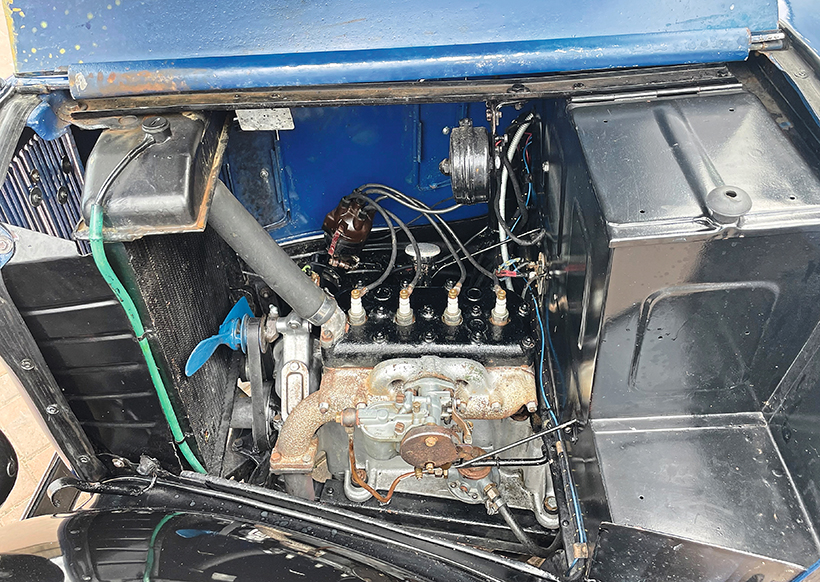
Larger engine bay of the Ruby van.
Convinced he was onto a definite winner; he put his own money into the project – so he could patent his inventions and ultimately demand a royalty on each and every car that would be built by the Austin Motor Co. In secret, he set up a drawing office away from the works – in his house, Lickey Grange, employing a young, 17-year-old, draughtsman, Stanley Edge, who had to get his parents’ permission to ‘live in’, he worked on a billiard table! It has been said that the initial drawings closely resembled the Rover 8. Three prototypes were built in a partitioned-off part of the works and shown to the directors – they wanted it.
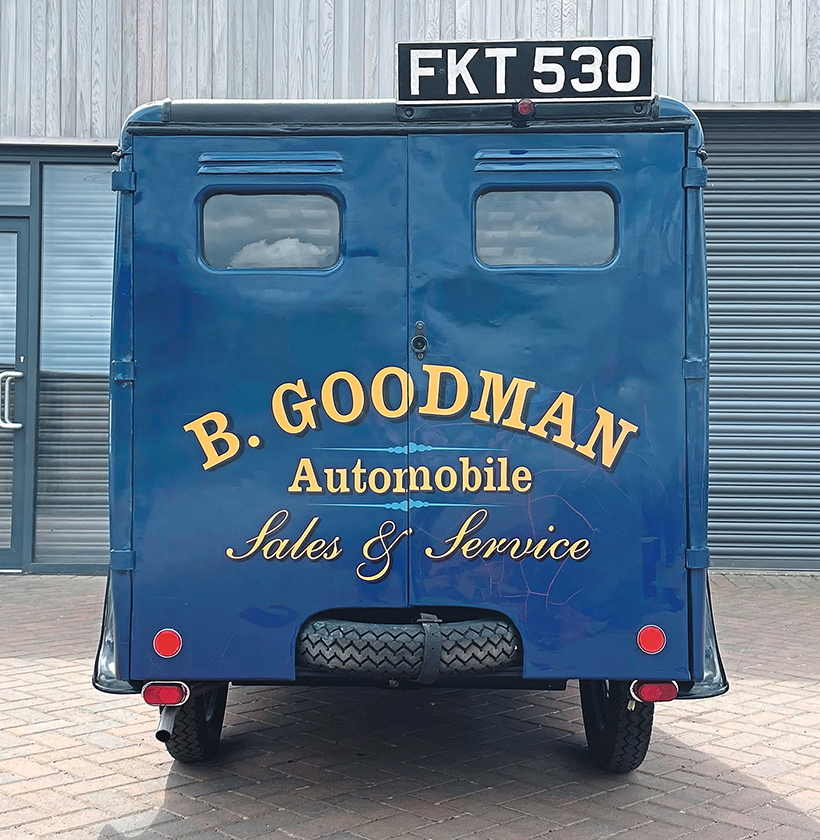
Rear doors cut-away to accommodate the spare.
When the Austin Seven was introduced in 1922 in Tourer form, it was a far more advanced design than the Rover or Peugeot, and would see it and most other cyclecar competitors off. Although the Seven had a small carrying capacity(2.5cwt), and small engine, it did have four cylinders and was water cooled – so it was quieter, smoother, and cheaper. It was originally going to have a flat twin engine, this was probably because all the vehicles he designed for his former employer, Wolseley, had flat twin, or single, cylinder engines. In the event, the Seven was quite different, young Edge had convinced Austin it should have had a four-cylinder 696cc (54mm x 76mm) water-cooled engine, with side valves, rated at 7.2hp.

Resurrected from a sad, rusty heap
Before the chassis was made available for commercial use in March 1923, the engine was enlarged to 747.5cc by increasing the bore to56mm, developing 10.5bhp. Cooling was by thermosyphon only; traffic was light so hold-up delays were almost unknown. The crankshaft ran on a pair of roller bearings – with a ball bearing added at the front to take end thrusts. These, and the bores, were lubricated by the oily mist in the crankcase and splash as oil was flung around. The oil pump fed a single gallery in the lower lip of the block leading to both camshaft bearings. From it a couple of screwed-in jets lined up with pockets in the crankshaft webs every revolution, and squirted lubricant into them; to feed the big ends. On these early models the oil pressure indicator consisted of a small wooden peg that began to protrude, more and more, from the dash – as the oil pressure rose.

Plenty of chrome on display.
Austin offered vans from October 1923, it did not do body vans at the factory, running chassis (complete with all frontend sheet metal) were driven to the nearby Thomas Startin coach building works. Very early versions featured very distinctive, heavy sculpturing, down the scuttle, short wheelbase, short radiator height and open cab. The bonnet was made of only three pieces; without a centre hinge until September 1926. No shock absorbers were fitted and no speedo; even today, vehicles registered before 1st October 1937 are not required to be fitted with a speedo! However, drivers exceeding the limit are still legally liable for prosecution – Austin fitted one from 1925, and when in 1934 the universal 30mph limit was introduced, speedometers had a noticeable red line marked on the dial.
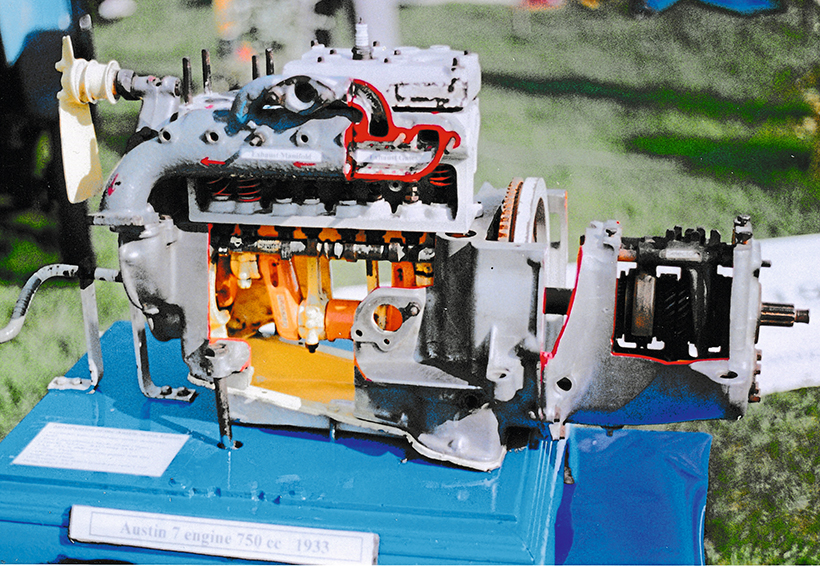
Sectioned Seven engine that first sparked a career in engineering for the author.
The three-speed, crash, gearbox, was built in-unit with the engine, it had a central, gate type change. A divided propeller shaft was fitted, the first section was open, the second enclosed inside a torque tube. The shafts were splined at their central joint; this in turn was carried on a large metal ball joint so the spiral bevel back axle’s movements could be accommodated. This joint and the rear universal joint for the first shaft; needed periodic greasing, they could be accessed from the relative comfort of inside the van – through two small holes in the floor. However, a short tube, complete with nipple, had to be attached in place of the screwed plug, this came above floor level and so easily accessed by the grease gun – obviously a leisurely job for a Sunday morning.
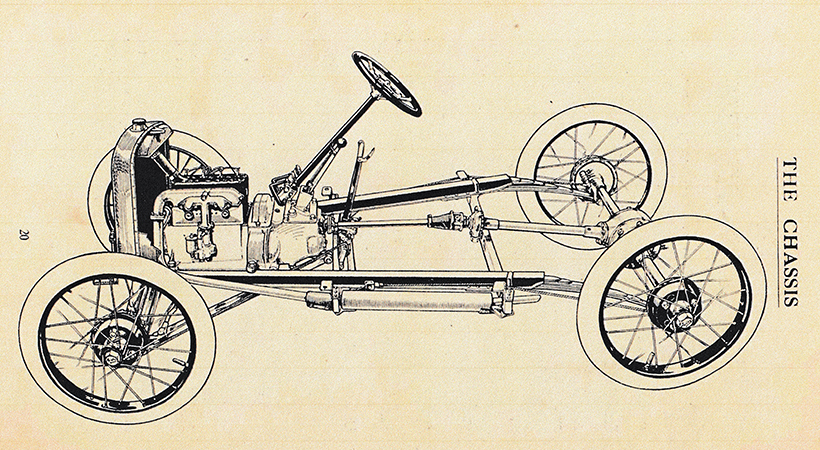
Seven running chassis.
The simple chassis was shaped like a large letter A, on early models it stopped after the driver’s seat. The two rear quarter elliptic springs were cantilevered backwards to support, and locate, the rear axle. The springs were anchored inside the chassis rail ends. A strong 22G steel floorpan carried the slightly thicker 24G aluminium body but the rear was unsupported; totally dependent on its own strength. The front spring’s centre was attached at its centre, this allowed the spring to accommodate bumps without distorting the chassis – almost independent front suspension!
A music hall joke at the time was: you need two – they’re roller skates! The public were amused, yet viewed it with great affection, and bought it. The motor trade had refused to have anything to do with it – until Austin threatened to sell it through cycle car and motor cycle dealers. Then, that focussed their collective minds and they grudgingly agreed. Wealthy customers of Austin limos who could not quite afford a Rolls-Royce or Bentley but had chauffeurs; were disgusted that the image would be tarnished when working class people could afford to be motorists. However, many eventually bought a Seven as a runabout!
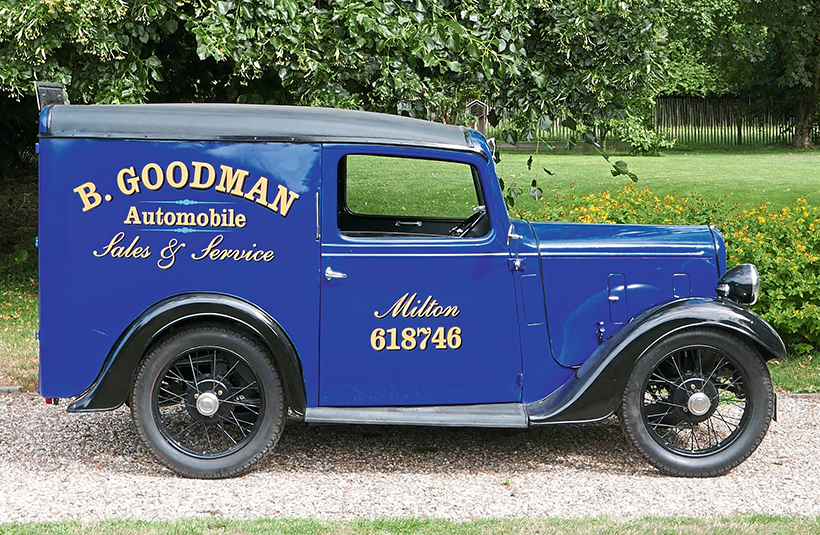
Still wearing its restorer’s livery.
After cracks appeared in the bodywork below the doors a modification was brought out, it consisted of fitting extension sections to the chassis legs to support the back half of the body. These extensions could also be retro-fitted to early vehicles; a service bulletin was issued to dealers detailing how this should be carried out, (owners could get the parts free if they wanted to fit them). Austin felt that the cracks were the result of gross overloading by owners – not a fault in the design! Since the carrying capacity was only 2.5cwt (although there was room for far more), this may have been true. No doubt owners felt that a small van should have been able to carry more – most did.

The magnificent Ruby van of 1939.
The front suspension consisted of a single, transverse, inverted, half elliptic spring. The axle was located by two radius rods that came back to a central ball joint. Friction dampers were not fitted on early chassis – so the ride was quite bouncy. And since the brake back plates did not overlap the edges of the drums; the ingress of grit and water could not be prevented – both making for an exciting ride. The Seven was the first small van to have brakes on all four wheels – but the front ones were operated by the handbrake, the rear by the footbrake! It was realised that the front ones would be the more powerful; and therefore, the most likely to induce a skid – so they were deliberately chosen to be operated by the handbrake; as this was considered to be applied more carefully and only in an emergency! Dunlop 3.50in x 19in balloon tyres on wire wheels were lighter than the disc type.
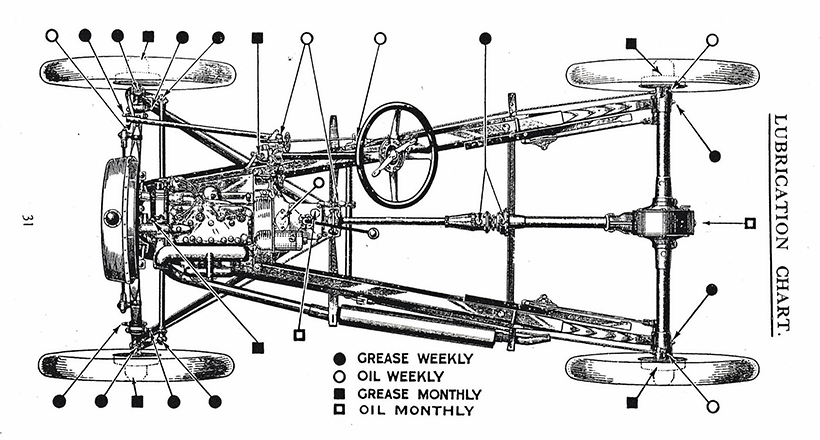
The simple Seven chassis.
The under-bonnet petrol tank did not have a gauge, the level had to be checked by peering into the tank, or rocking the vehicle, so assessing the amount of petrol from the splashing sound this made. The early electrics were by CAV of Acton, London. Charles Anthony Vandervell (CAV) started out in 1892 making batteries, in 1926 his company was bought by Joseph Lucas. The switchboard was a small circular disc with a large ammeter very prominent. Below were three pull type switches, and at the bottom a fuse protecting the dynamo.
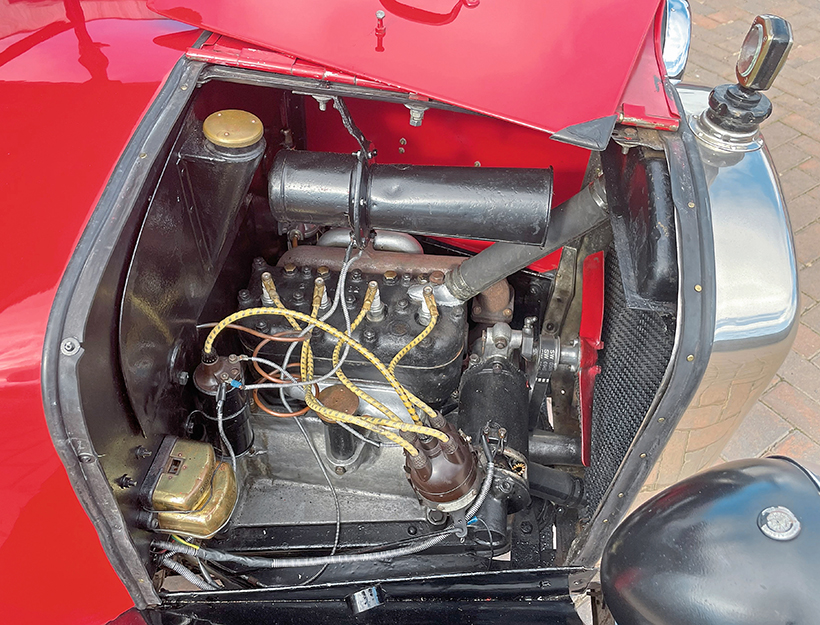
The tiny Seven engine did have four cylinders – like bigger ones.
Improvements came frequently as running experience highlighted short comings. From November 1923, a cooling fan was fitted, and from January 1924 a mechanical starter could be fitted at the factory as an optional extra. It was a rare luxury fitted only to a few of the very early vehicles. It was very much like a recoil starter on a petrol lawnmower. If it was requested then the flywheel had to be fitted with a toothed ring, the assembly was bolted to the top of the bell housing and protruded considerably into the cab footwell. It was operated by first pushing a shaft carrying the straight cut gear forward into mesh with the flywheel ring gear. It required a sharp powerful pull on a wooden handle tied to a wire rope, this action turned the engine over. Although it allowed the engine to be started from the driving seat, it was only suitable for restarting a stalled engine – within a month an electric starter became available but that also took up space in the passenger’s footwell and was recommended only for starting a warmed-up engine. If firing up from cold; then the starting handle should be used!
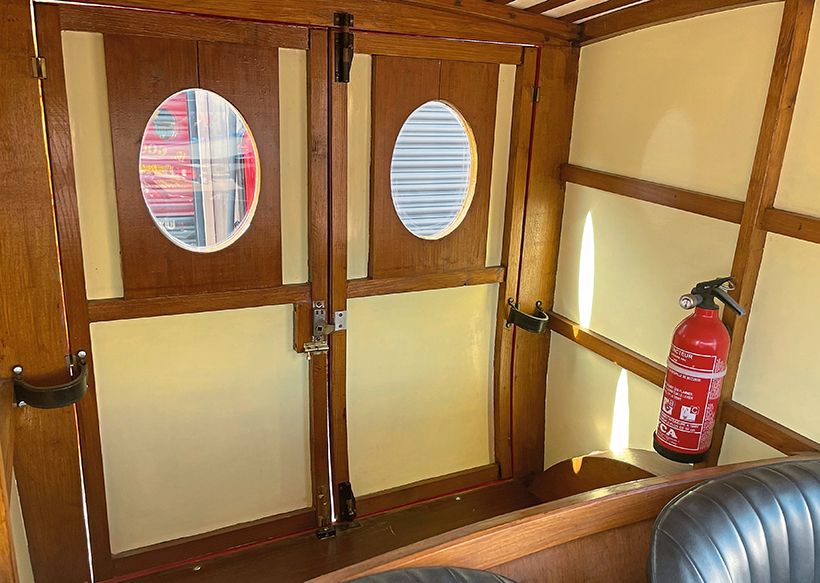
Tiny but well finished load area.
A very extensive toolkit was provided. It contained: a grease gun and adaptor called ‘Enots’ (Stone name reversed) maker Benton & Stone. The smaller items rolled up neatly in a fabric wrap (made from upholstery off cuts), stored under the driver’s side of the cab seat. Larger items, such as jack and its handle, and long handled tyre pump, handbook and spares booklet, valve spring compressor and even a spare head gasket, were kept behind the bench seat. In running chassis form the Seven cost £92, or £180 for a complete van.
Herbert Austin did get a royalty of 2 guineas per car (£2.10) – 290,000 would eventually be made! Very much later, BMC, would try and resurrect the name Seven when the new A30 was launched – it didn’t catch on. It tried yet again with the new Austin version of the Morris Mini-Minor using the gimmicky spelling: Austin Se7en, but again the buyers just called theirs a Mini. In the public’s eye the only treasured, revered memories were of the original Seven.
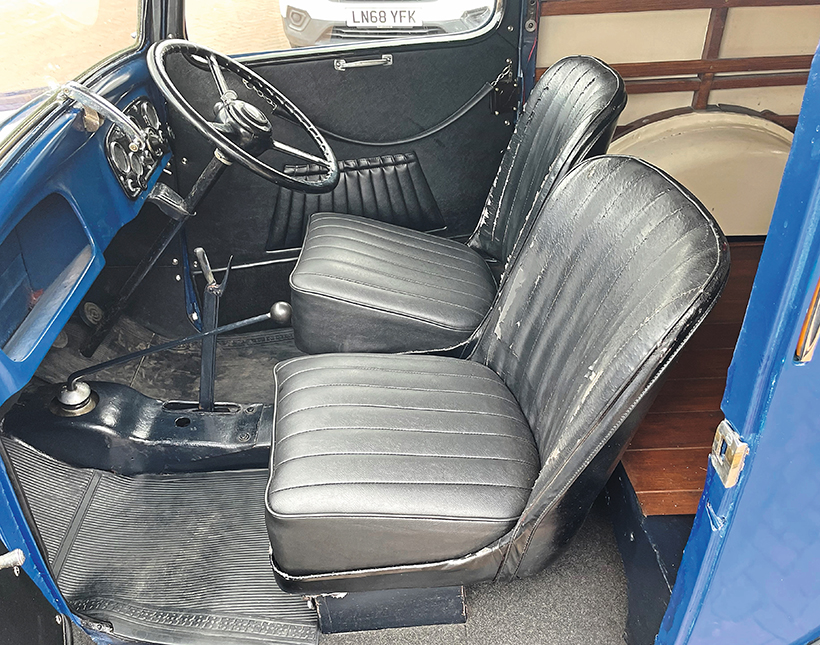
Two very comfy cab seats.
My thanks to Nigel Ricardo, Admin for the Dorset A7 Club, for technical support. Finally, I recently came across the old switch board from my father’s Seven – as a toddler I might have taken a fancy to it during a rebuild and hidden it in my toy box – it was among my old dinky toys!
This feature comes from the latest issue of Heritage Commercials, and you can get a money-saving subscription to this magazine simply by clicking HERE



